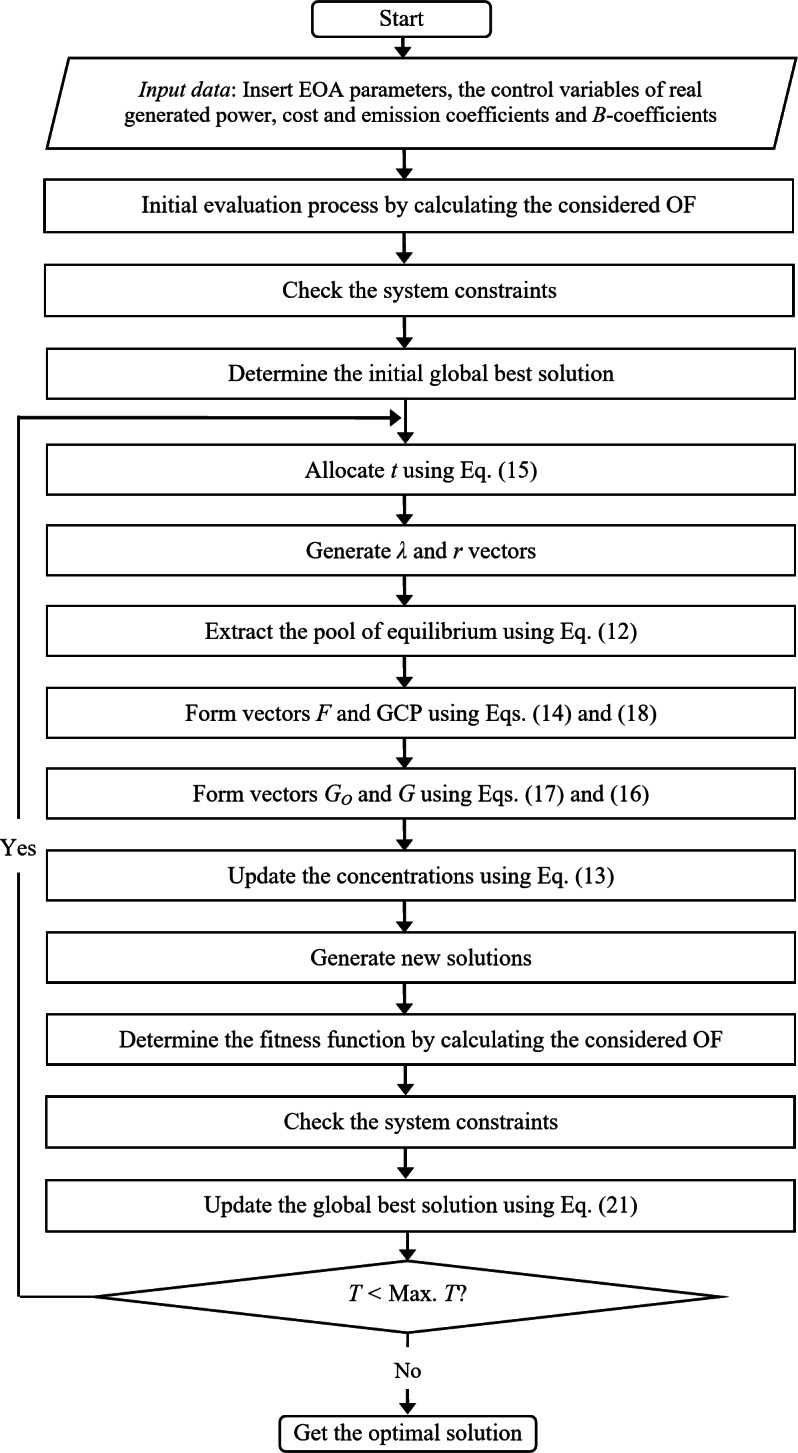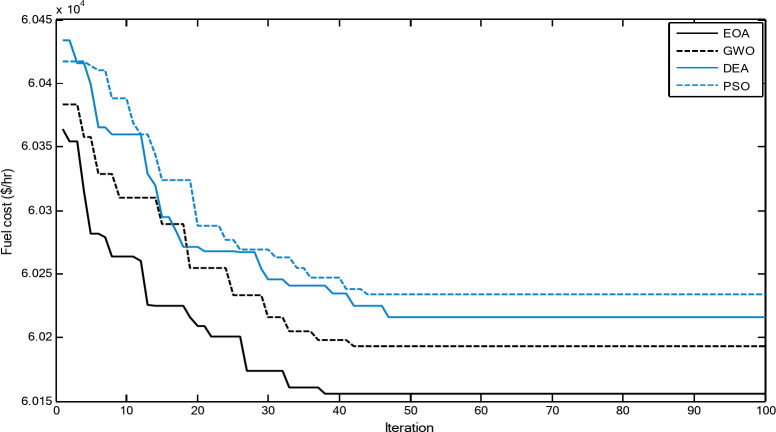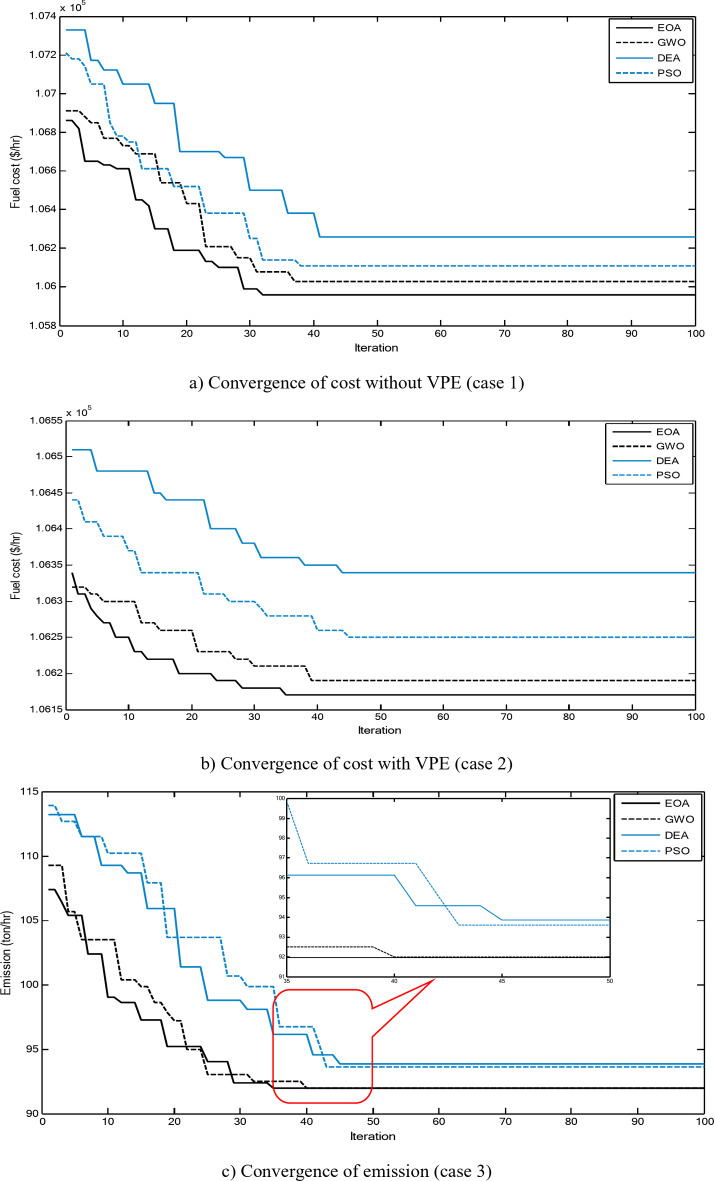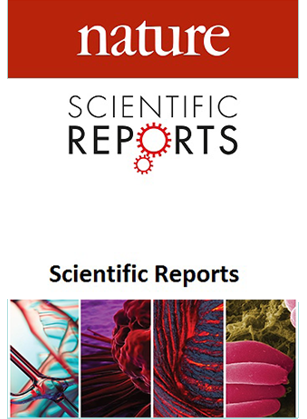基于均衡优化算法的电力系统多维经济环境运行。
摘要
由于互联电力系统的复杂性和目标函数的非线性特性,经济排放负荷调度问题是电力系统运营商面临的主要挑战之一。因此,在电力系统中,电场问题因其具有重要的目标而备受关注。为此,本文提出了平衡优化算法(EOA),在考虑系统约束和运行约束的情况下,以最小化总燃料成本和排放为目标来解决电力系统中的EELD问题。在考虑和不考虑阀点效应(VPE)和传动系统损耗的情况下,对OFs进行了优化。考虑了同时优化这些目标的多重of算法。在提出的EOA中,药剂是粒子和浓度,分别表示溶液和位置。通过几个案例研究,在不同尺寸的标准测试系统上对提议的EOA进行了评估和测试,这些测试系统有10、20、40和80个发电机组。将所提出的EOA的数值结果与其他优化技术如灰狼优化、粒子群优化(PSO)、差分进化算法等进行了比较。为了证明所提出的算法在考虑和不考虑VPE、斜坡速率限制(RRL)和发电机组禁止操作区域(POZs)等不同实际约束条件下求解大型电力系统所考虑的OFs的可靠性,在140台机组测试系统上对所提出的EOA进行了评估和测试。此外,所提出的多目标EOA (MOEOA)成功地获得了Pareto最优前沿,从而在考虑的OFs之间找到最佳折衷解。同时,对EOA与其他优化方法进行了统计分析和Wilcoxon签名秩检验。从数值结果来看,在不考虑VPE的情况下,使用所提出的EOA获得的总燃料成本比PSO的结果分别降低了0.1414%、0.1295%、0.6864%和5.8441%,10、20、40和80台机组的最大燃料成本分别节省了150美元/小时、78美元/小时、820美元/小时和14,730美元/小时。与基本情况相比,考虑VPE的总燃料成本分别降低了0.0753%、0.2536%、2.8891%和3.6186%,分别为10、20、40和80台发动机最大节省80美元/小时、158美元/小时、3610美元/小时、9230美元/小时。总排放量在10、40和80台时分别比基本情况减少了1.7483%、12.8673%和7.5948%。对于140个单元的测试系统,与PSO相比,不考虑VPE, RRL和poz的总燃料成本分别降低了6.4203%和7.2394%,最大节省了107,200美元/小时和126,400美元/小时。总排放量比基本情况减少了25688%。对比研究表明,随着系统规模的增大,EOA能够更准确、更高效地解决EELD问题,对电力系统的经济/环境运行具有优越性。



The economic emission load dispatch (EELD) problem is one of the main challenges to power system operators due to the complexity of the interconnected power systems and the non-linear characteristics of the objective functions (OFs). Therefore, the EELD problem has attracted significant attention in the electric power system because it has important objectives. Thus, this paper proposes the equilibrium optimization algorithm (EOA) to solve the EELD problem in electrical power systems by minimizing the total fuel cost and emissions, considering system and operational constraints. The OFs are optimized with and without considering valve point effects (VPE) and transmission system loss. The multi-OF, which aims to optimize these objectives simultaneously, is considered. In the proposed EOA, agents are particles and concentrations that express the solution and position, respectively. The proposed EOA is evaluated and tested on different-sized standard test systems having 10, 20, 40, and 80 generation units through several case studies. The numerical results obtained by the proposed EOA are compared with other optimization techniques such as grey wolf optimization, particle swarm optimization (PSO), differential evolution algorithm, and other optimization techniques in the literature. To show the reliability of the proposed algorithm for solving the considered OFs on a large-scale power system with and without considering different practical constraints such as VPE, ramp-rate limits (RRL), and prohibited operating zones (POZs) of generating units, the proposed EOA is evaluated and tested on the 140-unit test system. Also, the proposed multi-objective EOA (MOEOA) successfully acquires the Pareto optimal front to find the best compromise solution between the considered OFs. Also, the statistical analysis and the Wilcoxon signed rank test between the EOA and other optimization techniques for solving the EELD problem are performed. From numerical results, the total fuel cost obtained without considering VPE using the proposed EOA is reduced by 0.1414%, 0.1295%, 0.6864%, 5.8441% than the results of PSO, with maximum savings of 150 $/hr, 78 $/hr, 820 $/hr, and 14,730 $/hr for 10, 20, 40, and 80 units, respectively. The total fuel cost considering VPE is reduced by 0.0753%, 0.2536%, 2.8891%, and 3.6186% than the base case with maximum savings of 80 $/hr, 158 $/hr, 3610 $/hr, 9230 $/hr for 10, 20, 40, and 80 units, respectively. The total emission is reduced by 1.7483%, 12.8673%, and 7.5948% from the base case for 10, 40, and 80 units, respectively. For the 140-unit test system, the total fuel cost without and with considering VPE, RRL, and POZs is reduced by 6.4203% and 7.2394%, than the results of PSO with maximum savings of 107,200 $/hr and 126,400 $/hr. The total emission is reduced by 2.5688% from the base case. The comparative studies show the superiority of the EOA for the economic/environmental operation of the power system by solving the EELD problem with more accuracy and efficiency, especially as the system size increases.

 求助内容:
求助内容: 应助结果提醒方式:
应助结果提醒方式:


